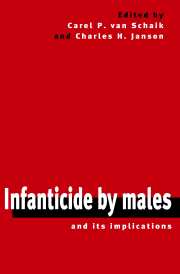Book contents
- Frontmatter
- Contents
- List of Contributors
- Foreword
- Infanticide by males: prospectus
- Part I Introduction
- Part II Infanticide by males: case studies
- Part III Behavioral consequences of infanticide by males
- 10 Prevention of infanticide: the perspective of infant primates
- 11 Infanticide and the evolution of male–female bonds in animals
- 12 The other side of the coin: infanticide and the evolution of affiliative male–infant interactions in Old World primates
- 13 Female dispersal and infanticide avoidance in primates
- 14 Reproductive patterns in eutherian mammals: adaptations against infanticide?
- 15 Paternity confusion and the ovarian cycles of female primates
- 16 Social evolution in primates: the relative roles of ecology and intersexual conflict
- Part IV Infanticide by females
- Part V Conclusion
- References
- Species index
- Subject index
16 - Social evolution in primates: the relative roles of ecology and intersexual conflict
Published online by Cambridge University Press: 04 November 2009
- Frontmatter
- Contents
- List of Contributors
- Foreword
- Infanticide by males: prospectus
- Part I Introduction
- Part II Infanticide by males: case studies
- Part III Behavioral consequences of infanticide by males
- 10 Prevention of infanticide: the perspective of infant primates
- 11 Infanticide and the evolution of male–female bonds in animals
- 12 The other side of the coin: infanticide and the evolution of affiliative male–infant interactions in Old World primates
- 13 Female dispersal and infanticide avoidance in primates
- 14 Reproductive patterns in eutherian mammals: adaptations against infanticide?
- 15 Paternity confusion and the ovarian cycles of female primates
- 16 Social evolution in primates: the relative roles of ecology and intersexual conflict
- Part IV Infanticide by females
- Part V Conclusion
- References
- Species index
- Subject index
Summary
Introduction
Infanticide by males is costly to females and so should select for female counterstrategies (Hrdy 1979; Smuts & Smuts 1993; van Schaik 1996; Ebensperger 1998a). Some of these hypothesized female counterstrategies are social, such as special relationships with “protector” males (Palombit et al. 1997). Female counterstrategies to infanticide may therefore explain important variation in primate social systems, including monogamy (van Schaik & Dunbar 1990), patterns of male–female association (van Schaik & Kappeler 1997) and female coalitions (Treves & Chapman 1996).
Female primates also face ecological pressures that may account for cross-species variation in social systems. For example, predation pressure may select for larger female groups, which then leads to greater withingroup competition for food resources (van Schaik 1989; Sterck et al. 1997). Additionally, predation pressure may select for an increase in the number of males in the group (Hall & DeVore 1965; van Schaik & Hörstermann 1994; Hill & Lee 1998), especially when males are more vigilant than females (van Schaik & van Noordwijk 1989) and when they deliver more effective communal defense (Stanford 1998).
The goal of this chapter is to examine the relative roles of ecology and intersexual conflict in primate social evolution. To achieve this goal we need independent estimates of the relevant ecological and intersexual pressures, but three issues complicate this effort. First, quantification of the relevant factors is difficult. For example, infanticide and predation are rare events, and when they do occur they often happen quickly and out of direct sight.
- Type
- Chapter
- Information
- Infanticide by Males and its Implications , pp. 388 - 420Publisher: Cambridge University PressPrint publication year: 2000
- 20
- Cited by

